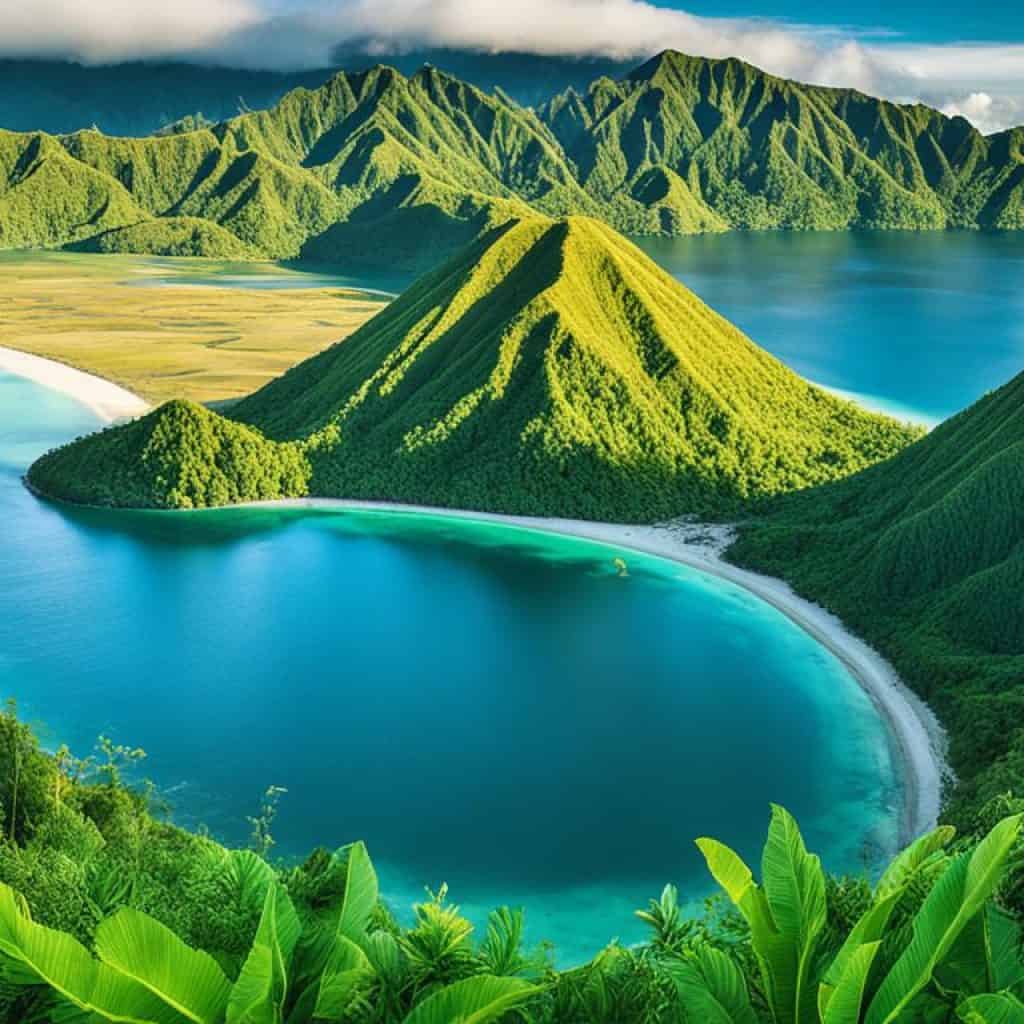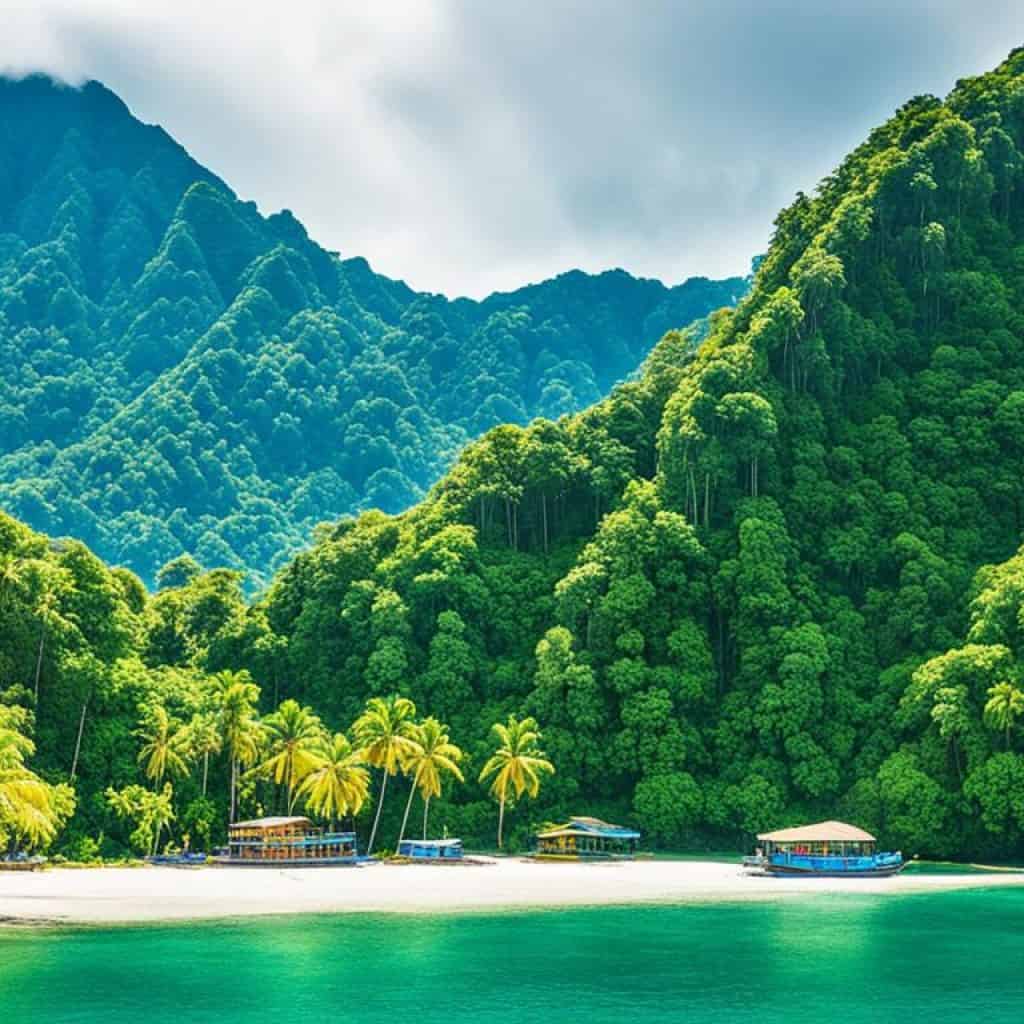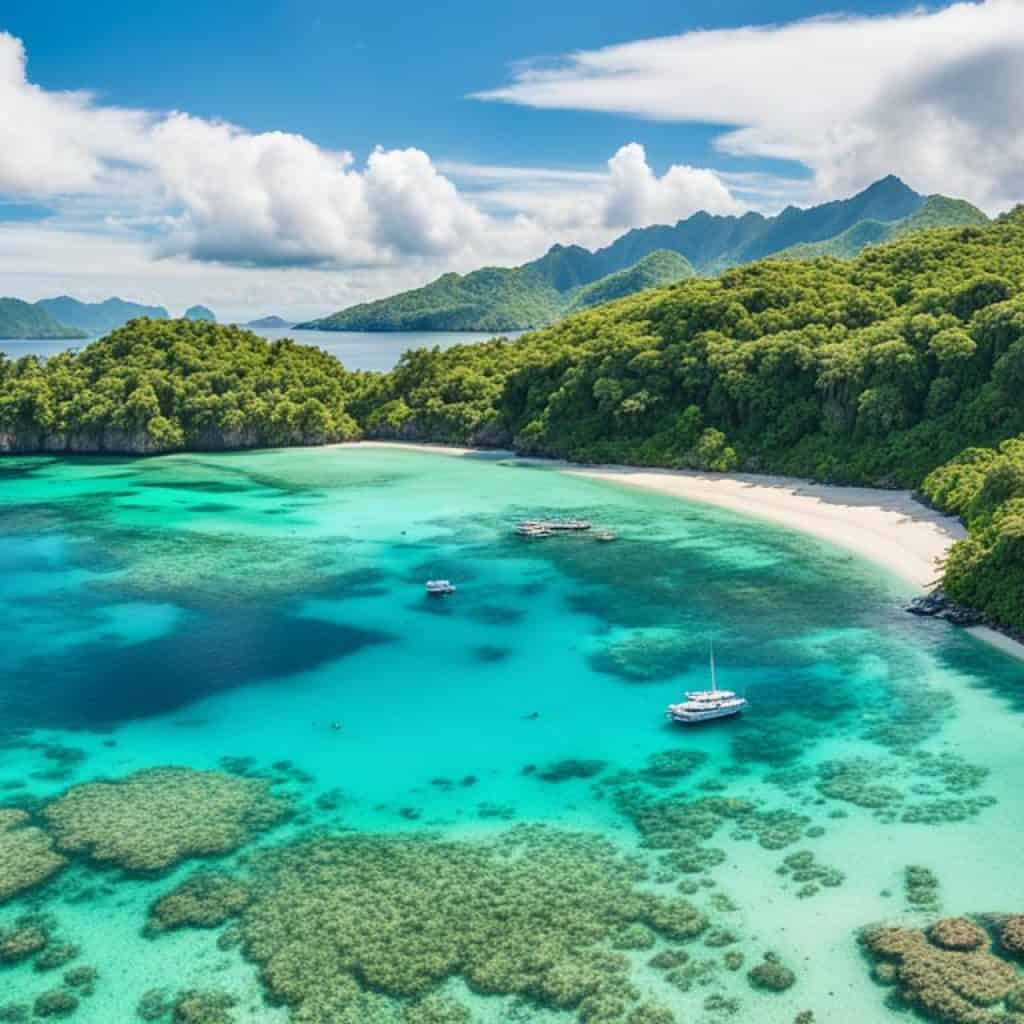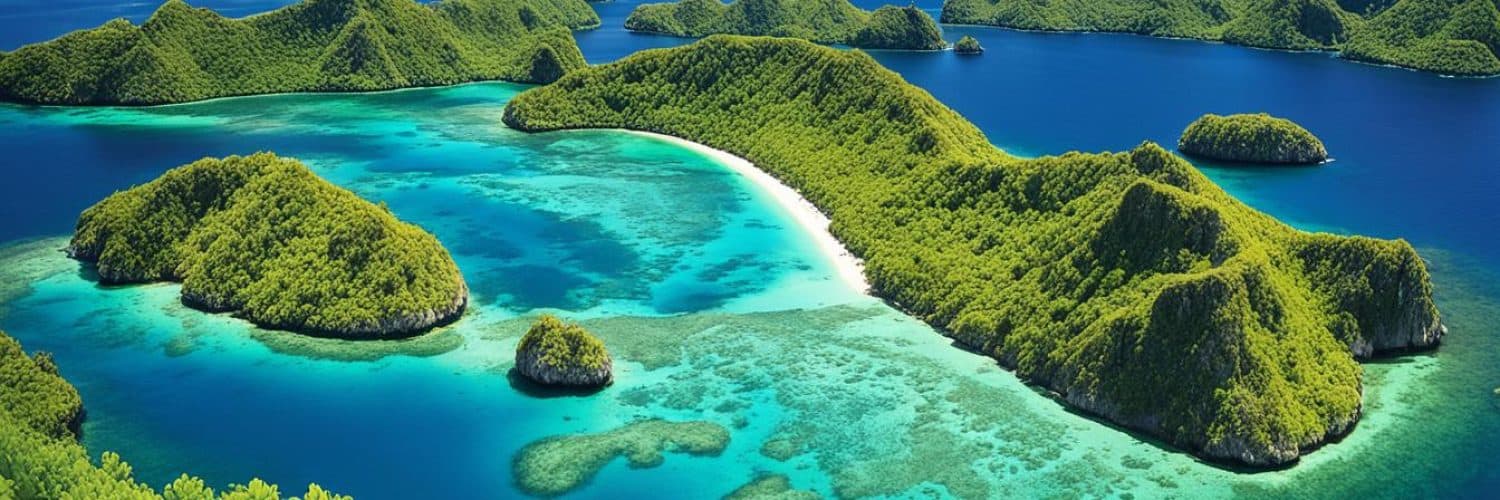When it comes to the Philippines, you may already have an image in your mind – crystal-clear waters, pristine beaches, and breathtaking landscapes. But have you ever wondered, what is the largest island in this tropical paradise? Is it the famous Boracay? Or perhaps Palawan, known for its stunning underground river? Prepare to be surprised as we reveal the answer to this intriguing question.
Overview of the Philippine Archipelago
The Philippines is composed of about 7,641 islands, forming the Philippine Archipelago. These islands are divided into three major groups: Luzon, the Visayas, and Mindanao. Luzon is the largest of these island groups and contains several major islands, including Mindoro, Palawan, and Catanduanes.
| Island Group | Major Islands |
|---|---|
| Luzon | Mindoro, Palawan, Catanduanes |
| Visayas | Panay, Cebu, Bohol, Leyte, Negros, Samar |
| Mindanao | Misamis Oriental, Bukidnon, Davao, Zamboanga, Surigao |
Each of these island groups offers unique landscapes, cultural heritage, and tourist attractions, making the Philippine Archipelago an incredible destination to explore.
The Top Five Largest Islands in the Philippines
When it comes to the Philippine archipelago, there are countless islands to explore. From stunning beaches to lush mountains, each island offers its own unique beauty and charm. Among these islands, five stand out as the largest in terms of land area and population. Let’s take a closer look at the top five largest islands in the Philippines: Luzon, Mindanao, Samar, Negros, and Palawan.
Luzon
Luzon takes the crown as the largest and most populous island in the Philippines. With a land area of approximately 109,965 square kilometers (42,458 square miles), it is home to thriving cities, breathtaking landscapes, and rich cultural heritage. Luzon is also where the capital city, Manila, is located, making it a hub of economic and political activities.
Mindanao
After Luzon, Mindanao is the second largest island in the Philippines. It covers an expansive land area of around 97,530 square kilometers (37,657 square miles). Mindanao boasts diverse cultural groups, stunning natural wonders, and the majestic Mount Apo, the highest peak in the Philippines.
Samar
Samar is the third largest island in the Philippines, with a land area of approximately 13,429 square kilometers (5,185 square miles). It may be smaller compared to Luzon and Mindanao, but it is still an enticing destination thanks to its beautiful beaches, enchanting waterfalls, and captivating caves.
Negros
Negros, with a land area of around 13,310 square kilometers (5,139 square miles), takes the fourth spot among the largest islands in the Philippines. It is known for its vast sugar plantations, picturesque landscapes, and the vibrant MassKara Festival held in Bacolod City.
Palawan
Rounding up the top five is Palawan, an island of approximately 12,189 square kilometers (4,706 square miles) in land area. Palawan is famous worldwide for its breathtaking beaches, crystal-clear waters, and the mesmerizing underground river, a UNESCO World Heritage Site.
| Island | Land Area (in square kilometers) | Population |
|---|---|---|
| Luzon | 109,965 | 64 million |
| Mindanao | 97,530 | 25 million |
| Samar | 13,429 | 1.88 million |
| Negros | 13,310 | 4.41 million |
| Palawan | 12,189 | 886,000 |
These top five largest islands in the Philippines offer a wealth of natural wonders, cultural experiences, and warm hospitality. Whether you’re looking to dive into the bustling city life of Luzon, explore Mindanao’s stunning landscapes, or relax on the picturesque shores of Palawan, each island has something unique to offer. Embark on an unforgettable journey and discover the beauty of these Philippine wonders.
Luzon: The Largest and Most Populous Island in the Philippines
Luzon, the largest Philippine island, dominates the archipelago with its vast land area of 109,965 square kilometers (42,458 square miles). But its significance goes beyond its size. With a population of around 64 million people, Luzon is also the most populous island in the country. It is a bustling region that showcases the dynamic spirit of the Philippines.

This image displays the breathtaking landscapes that make Luzon a remarkable destination. With its lush mountains, crystal-clear rivers, and stunning coastlines, the island offers a diverse range of natural wonders for visitors to explore.
Luzon: A Cultural Melting Pot
“Luzon is not just about its size or population. It is a vibrant tapestry of cultures, blending indigenous Filipino traditions with the influences of Spanish colonization and other Asian cultures. The result is a rich and diverse cultural heritage.”
The island is home to the capital city of Manila, a bustling metropolis known for its historic sites, modern infrastructure, and vibrant nightlife. But beyond the urban jungle, Luzon also boasts charming towns and picturesque provinces that showcase its cultural richness.
Exploring Luzon’s Unique Attractions
When visiting Luzon, there are several must-see destinations that capture the essence of the island:
- Batanes: Located in the far north, Batanes is known for its breathtaking landscapes, ancient stone houses, and preserved Ivatan culture.
- Rice Terraces of Banaue: These terraces, carved into the mountains of Ifugao, are a UNESCO World Heritage Site and a testament to the ingenuity and agricultural heritage of the indigenous people.
- Mount Pinatubo: This active volcano offers adventurous travelers the opportunity to hike and witness the stunning crater lake that formed after a major eruption in 1991.
- Pagudpud: With its pristine beaches and crystal-clear waters, Pagudpud is a paradise for beach lovers and water sports enthusiasts.
Luzon: A Gateway to Philippine Adventure
“Luzon’s size and population make it a perfect starting point for exploring the rest of the Philippine archipelago. From Luzon, travelers can easily access other major islands like Visayas and Mindanao, each offering their own unique wonders.”
Luzon’s strategic location, diverse landscapes, and vibrant culture make it an ideal gateway for exploring the Philippines. Whether you’re seeking adventure, relaxation, or a deeper understanding of Filipino heritage, Luzon is the perfect starting point for an unforgettable journey through the country’s natural and cultural wonders.
Mindanao: The Second Largest Island in the Philippines
Mindanao, the second largest island in the Philippines, spans an impressive land area of 97,530 square kilometers (37,657 square miles). This expansive island is home to a thriving population of approximately 25 million people, making it a vibrant and diverse region.
Mindanao is known for its rich cultural heritage, with various ethnic groups coexisting harmoniously. The island’s cultural tapestry is a testament to the Philippines’ multicultural identity, offering visitors a glimpse into the traditions, languages, and customs of its inhabitants.
Aside from its cultural significance, Mindanao is renowned for its breathtaking natural beauty. The island boasts stunning landscapes, lush rainforests, and pristine beaches that captivate the senses. Nestled within its scenic vistas is Mount Apo, the highest peak in the Philippines, which attracts hikers and nature enthusiasts from around the world.
Whether you’re exploring the vibrant city life of Davao, indulging in the beauty of the Enchanted River in Surigao del Sur, or immersing yourself in the unique cultural experiences of the T’bolis in Lake Sebu, Mindanao offers a multitude of unforgettable experiences.
“Mindanao is a treasure trove of cultural diversity and natural wonders. Immerse yourself in the captivating beauty of the island and discover the unique traditions of its people.”
Samar: The Third Largest Island in the Philippines
Samar is an island located in the Philippines and is the third largest in terms of land area. Spanning 13,429 square kilometers (5,185 square miles), Samar offers a diverse range of natural landscapes and attractions.
With a population of approximately 1.88 million people, Samar is home to a vibrant community with a rich cultural heritage. The island is known for its warm and welcoming locals who take pride in their traditions and way of life.
One of Samar’s main attractions is its breathtaking beaches. From the powdery white sands of Calicoan Island to the stunning rock formations of Biri Island, beach lovers are in for a treat. The crystal-clear waters provide the perfect backdrop for swimming, snorkeling, and diving adventures.
Samar is also blessed with impressive waterfalls that showcase the island’s natural beauty. Tinuy-an Falls, often referred to as the “Niagara Falls of the Philippines,” is a must-visit destination for nature enthusiasts. The multi-tiered cascades are a sight to behold and offer a refreshing respite from the tropical heat.
If you’re an adventurer at heart, Samar’s natural caves are waiting to be explored. The Langun-Gobingob Cave System, one of the largest cave networks in the country, offers a thrilling underground experience. Marvel at the unique rock formations and discover the hidden wonders that lie beneath the surface.
Samar is a paradise for nature lovers and adventure seekers. Its beautiful beaches, majestic waterfalls, and captivating caves make it a truly remarkable destination.
Samar at a Glance
| Land Area | Population |
|---|---|
| 13,429 square kilometers (5,185 square miles) | Approximately 1.88 million people |
Whether you’re seeking relaxation on pristine beaches, adventure in natural wonders, or an immersion into local culture, Samar has something for everyone. Explore this spectacular island and create unforgettable memories in the heart of the Philippines.
Negros: The Fourth Largest Island in the Philippines
Negros, known as the fourth largest island in the Philippines, spans a land area of 13,310 square kilometers (5,139 square miles). With a population of approximately 4.41 million people, this vibrant island is a hub of cultural and natural attractions.
One of the highlights of Negros is its flourishing sugar industry, which has earned it the title of the “Sugar Bowl of the Philippines”. Vast sugar plantations dot the landscape, contributing to both the island’s economy and its scenic beauty.
Aside from its agricultural prominence, Negros boasts breathtaking landscapes that showcase its natural wonders. From majestic mountains to picturesque coastlines, the island offers an array of outdoor adventures for nature enthusiasts.
Beyond its natural beauty, Negros is also known for its lively festivals. One of the most famous is the MassKara Festival held in Bacolod City, the capital of Negros Occidental. This vibrant celebration of music, dance, and extravagant costumes attracts locals and tourists alike.
Immerse yourself in the rich culture and warm hospitality of Negros as you explore its diverse attractions. Experience the charm of this fourth largest Philippine island and create unforgettable memories amid its stunning landscapes and vibrant festivals.

| Land Area | Population |
|---|---|
| 13,310 square kilometers (5,139 square miles) | Approximately 4.41 million people |
Palawan: The Fifth Largest Island in the Philippines
Palawan is a stunning island located in the western part of the Philippines. With a land area of 12,189 square kilometers (4,706 square miles), it is the fifth largest island in the country. Palawan is known for its natural beauty, pristine beaches, and crystal-clear waters. It offers a tranquil escape for those seeking a peaceful retreat.
With a population of approximately 886,000 people, Palawan is a paradise that is not overcrowded. The island’s vast land area allows visitors to find their own secluded spot, away from the hustle and bustle of city life. Palawan is truly an oasis of serenity.
“Palawan is not just an island, it’s a dream destination for nature lovers and adventurers,” says Maria Santos, a travel enthusiast who recently visited Palawan. “From the turquoise waters of El Nido to the stunning cliffs of Coron, Palawan’s beauty is simply unparalleled.”
| Land Area | Population |
|---|---|
| 12,189 square kilometers (4,706 square miles) | Approximately 886,000 people |
One of the highlights of Palawan is its underground river, which is recognized as a UNESCO World Heritage Site. This natural wonder boasts a mesmerizing labyrinth of caves, stalactites, and stalagmites. Exploring the underground river is an awe-inspiring experience that takes visitors into the heart of Palawan’s enchanting beauty.
Palawan also offers a wide range of outdoor activities for adventure enthusiasts. Whether it’s snorkeling, diving, hiking, or island hopping, there is no shortage of thrilling experiences to be had. The island’s diverse ecosystem is home to an array of plants, animals, and marine life, making it a haven for nature lovers and wildlife enthusiasts.
As you wander along Palawan’s pristine beaches, you’ll be captivated by the breathtaking sunsets and the peaceful rhythm of the ocean waves. It’s a place where time stands still, allowing you to immerse yourself in the tranquility and natural beauty that Palawan has to offer.
Other Major Islands in the Philippines
In addition to the top five largest islands, the Philippines is home to several other major islands that showcase the country’s diverse natural beauty and rich cultural heritage. Let’s explore two of these remarkable islands: Mindoro and Catanduanes.
Mindoro: Stunning Beaches and Diverse Wildlife
Mindoro is a captivating island located in the western part of the Philippines. It is known for its pristine beaches, crystal-clear waters, and vibrant marine life. Whether you’re looking to relax on the powdery white sands or explore the underwater world through snorkeling or diving, Mindoro offers breathtaking coastal scenery that will leave you in awe.
Aside from its stunning beaches, Mindoro is also a paradise for nature enthusiasts. The island boasts lush rainforests, majestic waterfalls, and diverse wildlife. You can embark on thrilling adventures, such as hiking through the mountains or spotting endemic species like the Mindoro tamaraw, a rare buffalo-like animal found only on the island. Mindoro truly offers a unique and unforgettable experience for nature lovers.
Catanduanes: Surfing and Majestic Waterfalls
Located in the Bicol Region of the Philippines, Catanduanes is a hidden gem that offers a mix of thrilling outdoor activities and picturesque landscapes. The island is known for its world-class surfing spots, attracting surfers from all over the world. With its powerful waves and pristine coastline, Catanduanes provides an excellent destination for surf enthusiasts of all skill levels.
Aside from its surfing allure, Catanduanes is also home to breathtaking waterfalls. You can immerse yourself in the tranquility of nature by visiting majestic waterfalls such as Maribina Falls and Balacay Point. These cascading wonders offer a refreshing retreat and the perfect backdrop for taking awe-inspiring photos.
Whether you’re seeking adventure or tranquility, Catanduanes has something to offer every visitor. With its stunning landscapes, vibrant culture, and warm hospitality, the island promises an unforgettable experience.
Exploring the Major Islands in the Visayas Region
The Visayas region in the central part of the Philippines is home to numerous islands that captivate visitors with their beauty and charm. Some of the notable islands in this region include:
- Bohol: Known for its famous Chocolate Hills and unique tarsier primates.
- Panay: Home to the picturesque island of Boracay, with its white sand beaches and vibrant nightlife.
- Cebu: Renowned for its historical sites, such as Magellan’s Cross, and stunning diving spots.
- Negros: Besides being one of the top five largest islands in the country, Negros is famous for its sugar plantations, vibrant festivals, and natural wonders like the spectacular Mambukal Falls.
These islands offer a myriad of attractions, including natural wonders, historical landmarks, and vibrant festivals that showcase the rich culture and heritage of the Philippines.
The Beauty of the Philippine Islands Continues
The Major islands in the Philippines, such as Mindoro, Catanduanes, and the various islands in the Visayas region, exemplify the country’s natural splendor. From stunning beaches and diverse wildlife to thrilling surfing spots and majestic waterfalls, these islands offer a wide range of experiences for every traveler. Whether you’re seeking relaxation, adventure, or cultural immersion, the Philippine islands are waiting to be explored.
Exploring the Natural Wonders of the Philippine Islands
The Philippine islands are a treasure trove of natural wonders and captivating tourist attractions. With its diverse landscapes and breathtaking sights, it offers an unforgettable experience for every traveler. From the magnificent rice terraces of Luzon to the pristine beaches of Mindanao, there is something to enchant and inspire everyone.
One of the must-visit destinations is the famous underground river in Palawan, a UNESCO World Heritage Site. Embark on a mesmerizing boat tour through this subterranean wonder, marveling at the intricate rock formations illuminated by sunlight filtering through the cave entrances. It’s an awe-inspiring experience that showcases the rich natural beauty of the Philippine islands.
For those seeking adventure and breathtaking views, a visit to the Chocolate Hills in Bohol is a must. These cone-shaped geological formations, named after their chocolate-colored grass during the dry season, are a sight to behold. Climb up to the viewing deck and be rewarded with a panoramic vista of these unique natural wonders spread across the landscape.
“The Philippines is a captivating destination, with a plethora of natural wonders waiting to be explored. From the underground river in Palawan to the Chocolate Hills in Bohol, every corner of this archipelago is filled with surprises and beauty.” – Travel Enthusiast
If you’re a diving enthusiast, don’t miss the chance to explore the pristine coral reefs of Tubbataha Reefs Natural Park. Located in the Sulu Sea, this marine sanctuary is a haven for marine life and offers some of the best diving experiences in the world. Dive into crystal-clear waters teeming with vibrant corals, tropical fish, and even the occasional sighting of majestic sea turtles and reef sharks.
Whether you’re a nature lover, an adventure seeker, or simply looking to unwind amidst stunning scenery, the natural wonders of the Philippine islands will surely captivate your heart and soul.

| Destination | Highlights |
|---|---|
| Rice terraces of Luzon | Stunning terraced landscapes, UNESCO World Heritage Site |
| Beaches of Mindanao | Pristine white sands, crystal-clear waters |
| Underground river in Palawan | UNESCO World Heritage Site, mesmerizing cave system |
| Chocolate Hills in Bohol | Unique cone-shaped geological formations, panoramic views |
| Tubbataha Reefs Natural Park | Pristine coral reefs, exceptional diving experiences |
The Cultural Richness of the Philippine Islands
The Philippine islands are not just known for their natural beauty but also for their rich and vibrant culture. Each island group has its own unique traditions, languages, and customs.
Luzon, the largest island in the Philippines, is known for its colorful festivals and historical sites. The annual Pahiyas Festival in Lucban, Quezon, is a celebration of the bountiful harvest, where houses are adorned with colorful decorations made of rice, fruits, and vegetables. Another popular festival in Luzon is the Panagbenga Festival in Baguio City, where locals showcase stunning flower floats and participate in street dancing competitions.
Mindanao, the second largest island, is home to diverse indigenous groups and a great diversity of traditional music and dance. The T’boli people in South Cotabato, for example, are known for their intricate weaving and vibrant costumes. They also celebrate their rich cultural heritage through music and dance, such as the melodic sounds of the Hegalong and the graceful movements of the Tinikling.
“The cultural diversity of the Philippine islands is truly a sight to behold. It’s fascinating to see how different regions in the country have their own unique customs, traditions, and even dialects.” – Juan dela Cruz, Cultural Enthusiast
The Visayas region, located in the heart of the Philippine archipelago, is famous for its lively fiestas and delicious cuisine. One of the most popular festivals in the Visayas is the Sinulog Festival in Cebu City, which honors the Santo Niño (Child Jesus). The festival features street dances, religious processions, and grand parades that showcase the region’s vibrant cultural heritage. When it comes to food, the Visayas is known for its mouthwatering delicacies, such as the famous lechon (roast pig) and the sweet and tangy piaya.
Cultural Highlights of the Philippine Islands
| Island Group | Traditions and Customs | Festivals | Cuisine |
|---|---|---|---|
| Luzon | Colorful festivals and historical sites | Pahiyas Festival, Panagbenga Festival | Bulalo, Bagnet, Adobo |
| Mindanao | Indigenous groups and traditional music and dance | T’boli weaving, Hegalong, Tinikling | Durian, Sinuglaw, Satti |
| Visayas | Lively fiestas and delicious cuisine | Sinulog Festival, Ati-Atihan Festival | Lechon, Piaya, Batchoy |
The cultural richness of the Philippine islands is a testament to the country’s diverse heritage. Exploring the traditions, festivities, and flavors of Luzon, Mindanao, and the Visayas is a truly rewarding experience that allows visitors to connect with the heart and soul of the Filipino people.
Economic Significance of the Philippine Islands
The Philippine islands, particularly Luzon and Mindanao, play a crucial role in the country’s economy. These islands serve as centers for various industries, making significant contributions to the Philippine economy.
Luzon, with its proximity to the capital city of Manila, functions as the main economic and political hub of the country. It is home to major industries, including manufacturing, agriculture, tourism, and services. The Luzon economy drives the growth and development of the Philippine economy as a whole.
Mindanao, the second largest island in the Philippines, also contributes significantly to the country’s economic landscape. It possesses rich natural resources and is known for its agricultural productivity. The Mindanao economy relies heavily on industries such as agriculture, mining, and manufacturing.
The combined efforts of Luzon and Mindanao contribute to the overall economic stability and growth of the Philippine economy. These islands provide employment opportunities, attract investments, and generate revenue for the country.
Major Industries in the Philippine Islands:
- Manufacturing
- Agriculture
- Tourism
- Services
These industries play significant roles in driving economic growth, creating jobs, and promoting sustainable development across the Philippine islands. They contribute to the country’s gross domestic product (GDP), exports, and overall economic prosperity.
“The diverse industries in Luzon and Mindanao are vital for the economic progress of the Philippines. By harnessing the abundant resources and opportunities in these regions, the country can achieve sustainable development and improve the lives of its people.” – [Name]
Conclusion
The Philippine islands, with Luzon as the largest and most populous, offer a diverse range of natural and cultural wonders to explore. Whether you’re a nature enthusiast, an adventure seeker, or a history buff, the Philippine islands have something for everyone.
From the pristine beaches and crystal-clear waters of Palawan to the majestic mountains and terraced rice fields of Luzon, the landscapes of the Philippine islands are nothing short of breathtaking. Whether you want to snorkel in vibrant coral reefs, hike to remote waterfalls, or simply relax on powdery white sands, the Philippine islands provide endless opportunities for relaxation and rejuvenation.
But the beauty of the Philippine islands extends beyond its landscapes. The islands are also home to a rich and vibrant culture, with each island group boasting its own unique traditions, languages, and cuisines. Immerse yourself in local festivals, taste exotic flavors, and witness traditional music and dance performances to truly experience the cultural richness of these islands.
Plan your visit to the Philippine islands and embark on an unforgettable journey through this incredible archipelago. Whether you want to explore the wonders of nature, immerse yourself in vibrant cultural experiences, or simply unwind in paradise, the Philippine islands await you with open arms. Discover the charm, beauty, and warmth of the Philippine islands and create lifelong memories.


















Add comment